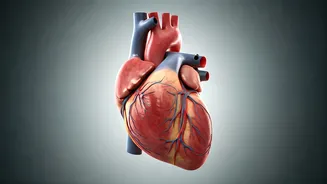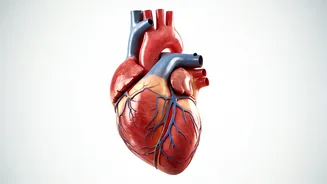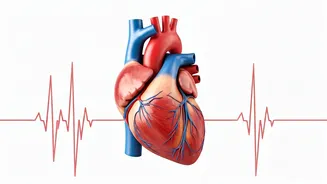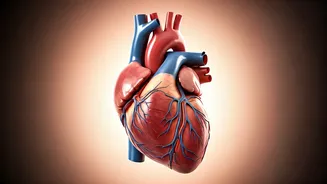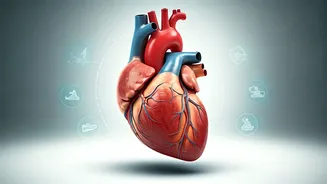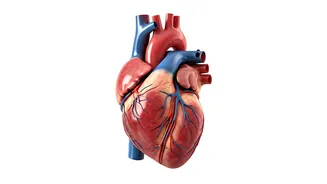Walking: Simple Yet Powerful
Walking is an excellent starting point for heart health, suitable for all fitness levels. It's a low-impact activity that gently elevates the heart rate,
improving cardiovascular function without straining joints. Start with short walks and gradually increase the duration and intensity as your fitness improves. Aim for at least 30 minutes of brisk walking most days of the week. Walking helps control weight, lowers blood pressure, and reduces the risk of heart disease, making it a cornerstone of a heart-healthy lifestyle. The beauty of walking lies in its simplicity and adaptability; it can be done almost anywhere, anytime, making it easy to fit into a busy schedule and supporting the body's natural movement and well-being.
Swimming: Gentle, Full Body
Swimming provides a full-body workout while being exceptionally gentle on the joints. This low-impact exercise is ideal for individuals of all ages and fitness levels, offering cardiovascular benefits without the stress of weight-bearing activities. The buoyancy of water reduces the strain on your body, allowing you to move freely and effectively. Swimming improves heart rate, strengthens muscles, and enhances endurance. Consistent swimming sessions contribute to lower blood pressure, improved cholesterol levels, and reduced risk of chronic diseases. Swimming is a refreshing and effective exercise that supports overall health and cardiovascular fitness. Furthermore, it's a great option for people with conditions like arthritis or those recovering from injuries, providing a safe and effective way to exercise.
Cycling: Enjoyable Cardio Boost
Cycling is a fun and effective way to boost heart health, offering a cardiovascular workout with minimal joint impact. Whether on a stationary bike or outdoors, cycling strengthens the heart and lungs, promoting better circulation and endurance. Regular cycling helps control weight, lowers blood pressure, and reduces the risk of heart disease. The intensity can be easily adjusted to suit your fitness level, making it accessible for beginners and challenging for experienced riders. Consider varying your cycling sessions with interval training – alternating between periods of high intensity and periods of recovery – to further enhance cardiovascular benefits and improve your fitness. Cycling is not only a great exercise but also an enjoyable activity, offering a refreshing way to stay active and healthy.
Yoga: Flexibility & Wellness
Yoga, a practice that combines physical postures, breathing techniques, and meditation, offers various benefits for heart health. Certain yoga poses can improve flexibility and strength, and some studies suggest it can reduce blood pressure and improve cholesterol levels. Regular yoga practice can also help manage stress, a significant factor in heart disease risk. Yoga provides a holistic approach to fitness, promoting relaxation and mindfulness, both crucial for cardiovascular well-being. By incorporating yoga into your routine, you can improve physical and mental health. Consider different styles of yoga, such as Hatha or Vinyasa, to find the one that best suits your needs and preferences, and consult with a qualified instructor to learn the proper techniques to maximize the benefits and avoid injuries.
Tai Chi: Gentle, Mindful Movement
Tai Chi, an ancient Chinese practice involving slow, graceful movements, is another excellent exercise for heart health. This low-impact activity combines physical exercise with meditation and deep breathing, offering several cardiovascular benefits. Tai Chi improves balance, coordination, and flexibility, and may reduce blood pressure and stress levels. It can be practiced by people of all ages and fitness levels, making it a versatile option for enhancing heart health. Regularly practicing Tai Chi can also improve mental well-being, promoting relaxation and reducing anxiety, factors that positively impact cardiovascular health. This gentle exercise provides a meditative experience and can easily be incorporated into any daily routine.
Elliptical Training: Low-Impact Cardio
Using an elliptical trainer provides a great cardiovascular workout with minimal stress on your joints. This machine simulates the motions of walking, running, and stair climbing, making it an excellent option for people looking for a moderate-to-high-intensity workout without the impact. Elliptical training helps improve heart rate, burn calories, and strengthen muscles throughout your body. Adjust the resistance and incline to vary your workouts, and consider incorporating interval training to boost its benefits. Elliptical trainers are found in many gyms and are also available for home use, providing a convenient way to stay active and support heart health. It's a great choice for those who want a varied, full-body workout that's easy on the body.
Stair Climbing: Simple, Effective
Stair climbing is a simple yet incredibly effective exercise for heart health. It elevates your heart rate quickly, helping to strengthen your cardiovascular system and burn calories efficiently. This exercise is easily accessible; you can climb stairs at home, in the office, or at the gym. Start slowly and gradually increase the number of stairs you climb and the pace at which you do so. Climbing stairs can improve leg strength and endurance, and it’s a great way to improve your overall fitness. Even short bursts of stair climbing throughout the day can have positive effects on your heart health. Regular stair climbing helps to improve your circulation and may reduce the risk of heart disease and related conditions, so it's a practical and beneficial exercise for all.
